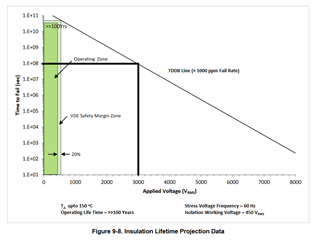Hi team,
I'm looking for some additional inputs to go along with the FMEA analysis / datasheet of ISO6720:
In the case where TDDB is exceeded and the isolation fails, is there any scenario where the device would fail short or does the dual cap isolation structure completely prevent this?
Are there any additional effects (other than affecting insulation lifetime) when the device sees higher than the working voltage? Is there any difference in device function / does operation remain normal up until the isolation fails when seeing a voltage below the max but above the working voltage for extended periods?
Do you have a function you can share that estimates TDDB at application temperatures rather than worst case scenario as shown in the datasheet?
Thanks and best regards
Dan


